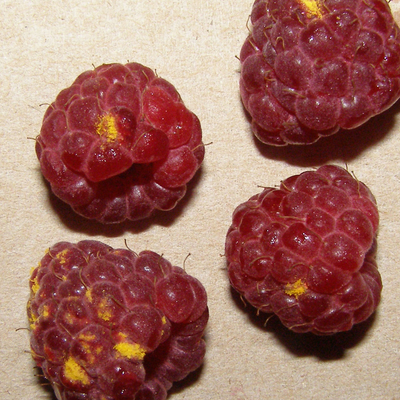Quick facts
- Late leaf rust is more common but less damaging than orange rust.
- Late leaf rust only infects red and black raspberries.
- Infected leaves and fruit have powdery yellow spots.
- Plant in a site with sun and good air circulation.
- To manage this disease, plant in narrow rows, remove weeds often and thin plantings that have become overgrown.
- Summer-bearing raspberries are less likely to have problems with late leaf rust than fall-bearing raspberries.
See Growing raspberries in the home garden for more information on keeping plants healthy.
How to identify late leaf rust
Fruit Symptoms
- Late leaf rust is most commonly seen on the fruit of fall-bearing raspberries.
- Typically, one to three drupelets (small, rounded sections of the raspberry fruit) will be covered with bright orange, powdery spores in September.
Leaf Symptoms
- Lower leaves of the plant are most likely to be infected.
- Small, yellow spots form on leaves.
- Clumps of powdery yellow or orange spores form on the underside of the leaf below leaf spots.
- Severely infected leaves may fall off.
- In rare cases, this disease can cause all the leaves to fall off of both summer-bearing and fall-bearing raspberries.
- Canes that lost all their leaves produce poorer quality fruit and less of it.
- These canes are also more likely to be damaged by winter injury.
How does late leaf rust survive and spread?
- Late leaf rust is caused by the fungus Pucciniastrum americanum.
- Like many rust diseases, the late leaf rust fungus has two hosts: the white spruce and raspberries.
- In areas with white spruces, spores are blown from infected spruce to nearby raspberry plants.
- In areas without spruce trees, late leaf rust can survive from one season to the next on infected raspberry canes.
- Infection usually starts on mature lower leaves. The higher humidity near the bottom of the plant helps the spores germinate.
- Infected raspberry leaves and fruit produce lots of powdery, yellow spores.
- These spores are carried by wind to infect new raspberry leaves and fruit throughout the growing season.
- The late leaf rust fungus survives the winter inside the crown of the raspberry plant and in infected spruce needles.
How to manage late leaf rust
Tolerate late leaf rust
Late leaf rust may discolor fruit in wet years but rarely reduces the number of fruit produced.
Plant summer bearing raspberries
- Summer-bearing raspberries are less likely to be infected by late leaf rust.
- Fall-bearing raspberries are much more likely to be infected.
- Heritage, a Minnesota hardy variety of red raspberry is known to significantly be affected by late leaf rust when conditions are favorable for disease.
- Check the label of new varieties for disease resistance information.
Provide good air circulation
Cultural practices that help raspberry plants dry quickly will help reduce late leaf rust.
- Maintain narrow rows.
- Use drip irrigation or water early on sunny days.
- Remove all old floricanes (last years canes) as well as any primocanes (first year canes) showing symptoms of disease.
- Removing infected canes will improve air movement through the patch and will also remove an overwintering site of the fungal pathogens.
Fungicides are not necessary to manage late leaf rust
Reviewed in 2024


